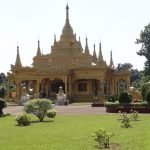A BLEEDING SHOULDER – INDIA’S NORTHEAST
The Kashmir insurgency having taken centre-stage for many years now, the insurgencies of the North-East no more occupy significant spaces of newsworthiness. Nevertheless, they are not dead as yet, lingering on preventing the region from going full steam on the road to development. This is an attempt to trace the histories of these insurgencies until 5 years ago when this study was undertaken. Nothing has changed drastically since then, with the insurgencies still existing or claiming to exist, with the formal burials yet to take place. Even the one notable development of the Government of India entering into a peace accord with NSCN (IM), the National Socialist Council of Nagaland (Isak-Muviah) in 2015, is yet to draw any dividends because the exact terms of the accord are yet to be made public and implemented. This is the ninth and final episode of a 9-blog series on the various ethnic insurgencies of the North-East, essentially meant to shed some light on this trouble-prone region’s problems, which large sections of ‘mainland Indians’ remain in the dark about even after nearly seven decades of the Republic taking shape.
9 Mizoram – Heralding a New Dawn
The story of Mizoram, an island of peace and progress in the ocean of violence that is Northeast India, makes a happy endnote to this chronicle of the region’s woes. The state of Mizoram ( the name meaning the ‘land of the hill people’), inaugurated on 20 February 1987, comprises the area that covered the Lushai Hills Autonomous District Council of the old Assam State which was formed in 1952 and later made a Union Territory in 1972. It shares borders with Bangladesh and Myanmar, besides the states of Assam, Manipur and Tripura.
The insurgency in the state – the grittiest and the most successful one anywhere in the country while it lasted – grew out of the neglect and discrimination meted out to the Mizos over the years by the Assam administration. The appeals of the Mizo Union – the only political party of the Lushai Hills (formed in 1946) – to the States Reorganization Commission (SRC) to integrate the Mizo-dominated areas of the neighbouring states with the Lushai Hills District largely went unheard. However what finally precipitated the rebellion was the infamous Mautam famine of late 1950s in the region and its tardy handling by the Assam Government. The introduction of Assamese as the official language in 1960 with no regard for the linguistic sentiments of the people added fuel to the fire.
The Mizo National Famine Front, a social organization formed to give succour to the famine victims, dropped the word ‘Famine’ to style itself as the Mizo National Front (MNF) and took up the cause of an armed struggle. The MNF demanded sovereignty – instead of statehood the Mizo Union had been demanding – and raised an armed militia, the Mizo National Army, which in turn came to be supported by a group of irregulars called the Mizo National Volunteers (MNV). The armed cadres received training and weaponry from erstwhile East Pakistan.
The leader of the movement, Pu Laldenga, was arrested by the Assam Government, but released in 1964. By the year end 1965, the MNF had a cadre-strength of over 2000 and a sizeable cache of arms and ammunition, either procured from East Pakistan or stolen from the armouries of Assam Rifles or the Border Roads Organization through raids and break-ins. They struck on 1st March 1966 in a well-coordinated operation codenamed ‘Jericho’ that took the district administration by surprise. In a matter of 24 hours they neutralized the government machinery and were in control of the district, except for the isolated paramilitary units that held on. It took as much time for the authorities outside the district to get the wind of what was happening as the insurgents had cut the telephone lines.
Alerted of the situation, the Assam Government invoked the Assam Disturbed Areas Act, 1955 and the Armed Forces (Special Powers) Act, 1958, proclaiming the entire district as disturbed area, on 2 March 1966. By 3 March, except for the 1st Assam Rifles holding on to their garrison in the capital town of Aizawl, all police and paramilitary posts had fallen to the insurgents. IAF helicopters began flying in reinforcements to the beleaguered 1st Assam Rifles. The copters found the going hard against intense fire from the insurgents. The next day, 4 March, they were escorted by fighters. The fighters ended up strafing Aizawl, intensifying the strikes the following day, 5 March, till most of the civilian population fled; the only instance – and a very sad one – when air power was used against own population by the Indian state.
Meanwhile two brigade groups of the Indian Army – one each from Silchar and Agartala – were mobilized. With the insurgents putting up roadblocks, the leading brigade could make it to Aizawl only by 6 March. The following day, 7 March, the 1st AR garrison was relieved. The MNF forces fell back to Lunglei. With the army pressing on hard, they kept withdrawing, abandoning one post after the other till they found themselves in the safety of the Chittagong Hill Tracts of East Pkistan. By 25 March 1966, the government was back in control of the entire Mizoram.
[The professionalism the MNF displayed in the operation was quite a bit attributable to the largely trained manpower it had. A number of ex-soldiers of the 2nd Battalion of the Assam Regiment (that had a high composition of Mizos), which had been disbanded for mutiny a few years earlier, joined the rebel ranks.]The insurrection had been nipped; but the MNF carried on with the fight through guerilla warfare. The army tried grouping of villages here too to keep the insurgents out, and it brought the ire of the people as much as the air strikes did. Ultimately the surrender of a large number of insurgents was brought about by an amnesty in 1968. By a combination of negotiations by the government and fraternization drives by the army – army medics who provided healthcare in remote villages and engineer and other units helping the people build schools or play grounds helped assuage the hurt feelings a lot – the insurgency diminished over the years, and in 1986 it finally ended with the signing of the Mizo Peace Accord.
[The wound that the 1966 air strikes on Aizawl inflicted on the collective psyche of Mizo people was still fresh even three years later, as this author realized when posted in Mizoram as a young army officer. I befriended the headmaster of the school at Vairengte, a village in the foothills of Mizoram where my unit was located. A fine conversationalist who could casually quote Shakespeare or Shelley (much to my embarrassment having had read just one of Shakespeare’s works at university and none of Shelley’s), he passionately recounted the outrage people felt about the air strikes. “Why did they have to bomb us?” he asked. “Would they have done it to Calcutta or Delhi?” Sentiments not too different from those the Sikhs expressed almost two decades later when the tanks of the Indian Army bludgeoned their way into the Golden Temple Complex at Amritsar. It is this kind of overkills – whether by the top brass or by those in the lower commands – that discredit the armed forces as a whole.While interacting with the people of the Northeast one could not help notice their fine tastes. In the 1960s and 70s most villagers in Mizoram or Nagaland lived in houses made of bamboo rather than any pukka constructions. However the elegant manner in which they maintained the drawing rooms of their humble abodes was something that had to be seen to be believed. Handmade lace curtains and embroidered sheets adorned their homes. The exquisite handicrafts of the Northeast, which are a class apart, embody the aesthetic sense of the people there.
Devoid of too many ambitions, the Mizos seemed to enjoy life’s little pleasures. Strolling along the streets of a remote place like Lunglei at dusk – with no street lights being lit since electricity had still not reached those places – one could hear the notes of guitar from almost every home. And come Christmas or New Year, it was party time – people of all ages singing and dancing with great abandon.]
When the state of Mizoram was formed in 1987, the rebel leader, Laldenga, became its first Chief Minister. The rest of the insurgent leadership too joined the mainstream politics. From then on Mizoram’s has been an unparalleled success story. Burying the past for good, the state invested its energy and resources on development so well that in less than three decades it has forged ahead as one of the most progressive constituents of the Indian Union; about to overtake Kerala in literacy. The laurels for this achievement must undoubtedly go to the insurgent leaders who remained united – there were no ‘split’ stories in Mizoram – and donned their new role with responsibility and vigour.
There have of course been some peripheral conflicts that have been contained or are well on the way to being contained. One such trouble concerned the Brus or the Reangs forced out of the state to move to Tripura in 1997 following ethnic riots. Some 17,000 of them were lodged in relief camps in Tripura, their number doubling by the year 2000. Delay over the repatriation of these people led to the growth of some militant outfits among them, like the Bru National Liberation Front (BNLF) and the Bru Liberation Front of Mizoram (BLFM), which have been indulging in sporadic acts of violence in Mizoram and Assam. Although the process of repatriation of the refugees was taken up in 2009, it got derailed by fresh riots causing further exodus. It has been initiated again in 2010 and going on since, albeit at a slow pace.
HPC-D (the Hmar People’s Convention-Democracy), an offshoot of the Hmar People’s Convention – HPC – formed in 1986 by Hmars who disagreed with the Mizo Accord, has been waging its own brand of extortionist insurgency in Mizoram, Manipur and Assam. The Hmar tribe lives in areas that spread across Mizoram, Manipur and Assam, and the insurgents want an autonomous administrative unit – ‘Greater Mizoram’ – integrating all these areas. The insurgency, which peaked in early 1990s, somewhat subsided after the surrender of most of the HPC cadres. But the radical faction, HPC-D, carries on with its activities, mostly within Manipur and Assam.
Yet another outfit, the Singlung Tiger Force (STF), formed in 2007 – later renamed as the Singlung People’s Liberation Army (SPLA) – with cadres recruited from among the Hmars, is reported to be active with bases in Mizoram and Manipur as well as Myanmar. The outfit professes to defend the rights of the Singlung people threatened by a proposed multi-purpose hydel project coming up in their area. Most of its cadres however laid down arms in 2009.
Barring these few irritant outfits that seemed to be kept well under check by the state police and a reported arms smuggling racket going on through Mizo territory, Mizoram enjoys a conducive environment for all-round development that is propelling the state forward. The number of young Mizos who now fan out to the rest of India to work or study – from the commercial centres of Delhi to the IT parks of Bangalore – manifests this triumphal spirit of their picturesque state.
[The 9-blog series on insurgencies in North-East India ends with this. To be followed by a summing-up article on the region’s imbroglio.]





